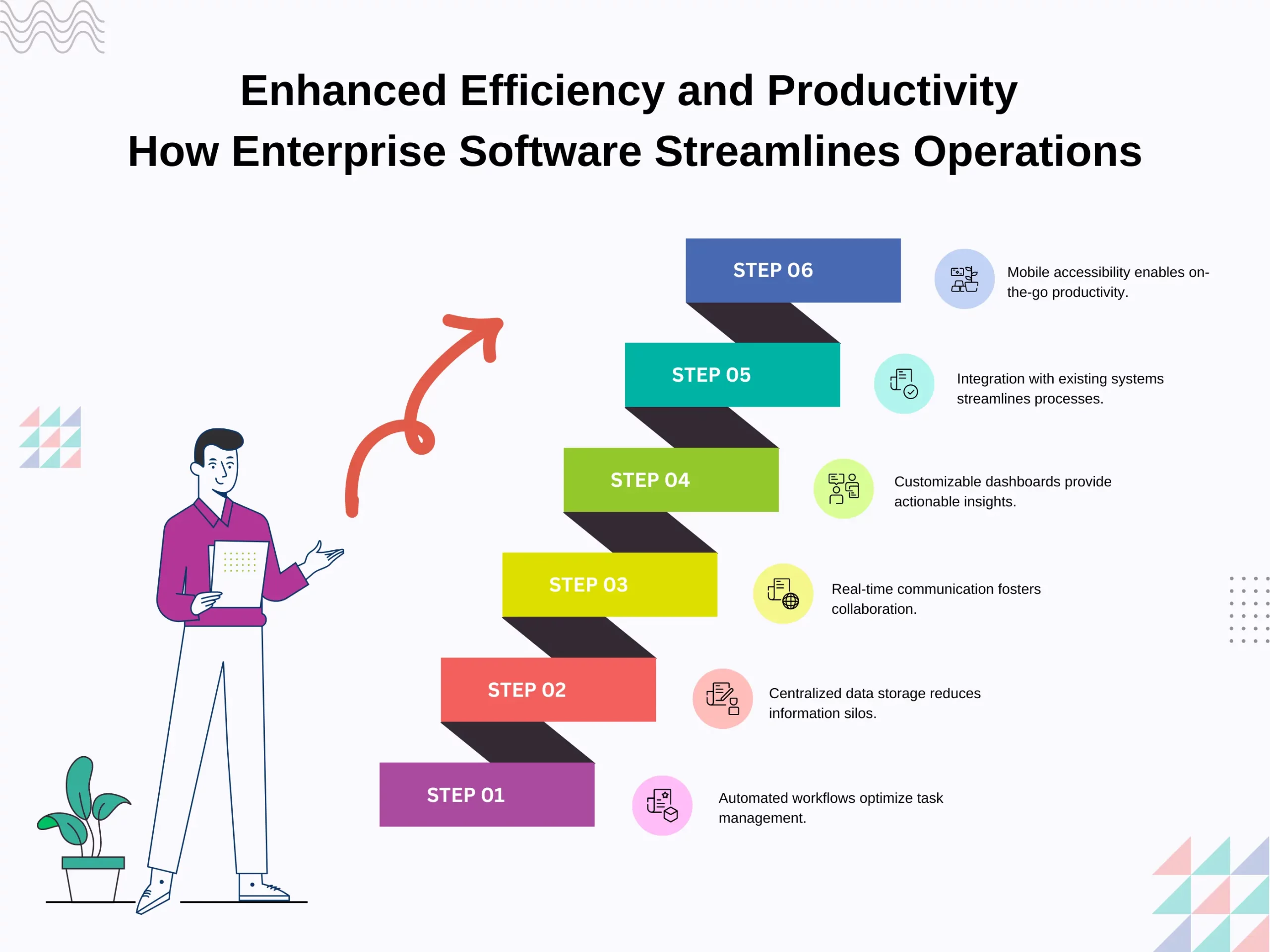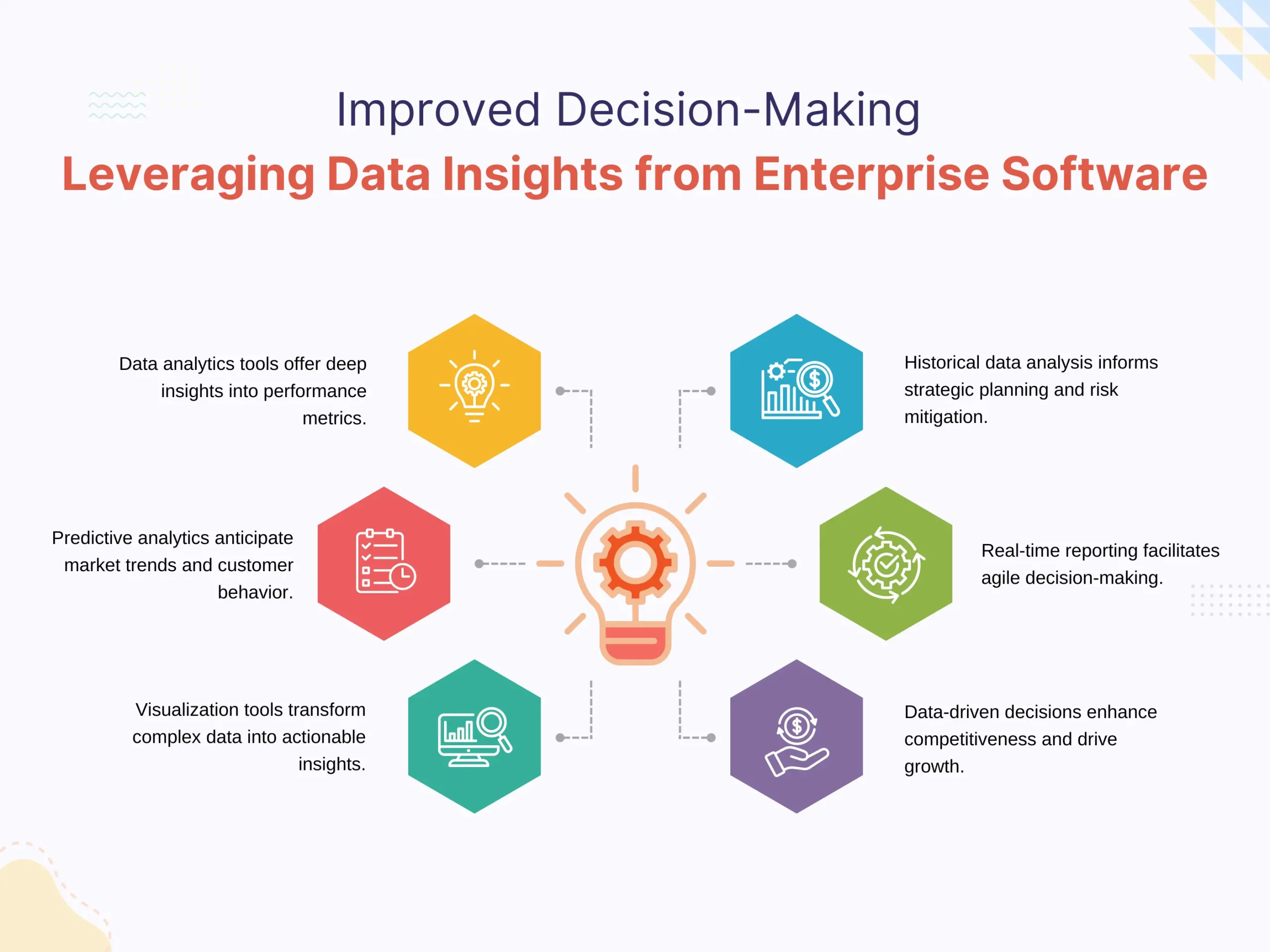The pressure to optimize operations and maintain a competitive edge is relentless. To meet these demands, organizations are increasingly turning to enterprise software, a versatile suite of applications tailored to address the specific needs of businesses. The impact of this software is profound, offering a plethora of benefits that are reshaping the operational landscape.
At the core of enterprise software’s appeal lies its capacity to drive efficiency gains. Data from a recent survey by Gartner indicates that organizations leveraging enterprise software report up to a 75% increase in operational efficiency compared to those without such solutions. By automating repetitive tasks, consolidating data management processes, and delivering real-time analytics. ERP software empowers businesses to make data-driven decisions swiftly and strategically allocate resources.
Moreover, collaboration among teams is significantly enhanced through the integration of enterprise software. Research conducted by McKinsey & Company reveals that companies with effective collaboration practices achieve, on average, a 20-30% increase in productivity. Moreover, enterprise software facilitates seamless communication and knowledge sharing across departments and geographical locations, fostering a culture of innovation and accelerating project delivery timelines.
The importance of data security and compliance cannot be overstated in today’s digital landscape. According to a report by IBM, the average cost of a data breach is $3.86 million, highlighting the critical need for robust security measures. Enterprise resource planning software offers advanced security features, including encryption protocols and access controls, to safeguard sensitive information and ensure regulatory compliance, mitigating the risk.
As organizations strive to navigate the complexities of the business environment, the adoption of enterprise software emerges as a strategic imperative for sustainable growth and competitiveness. Over the following sections, we will delve into the top 15 benefits of incorporating enterprise software into your organization, exploring how this transformative technology can propel your business toward greater success.

Introduction to Enterprise Software: A Brief Overview and Its Role
Enterprise software stands as a cornerstone of modern business operations, offering a comprehensive suite of applications designed to address the diverse needs of organizations across various industries. At its core, enterprise software plays a pivotal role in optimizing efficiency, fostering collaboration, and ensuring regulatory compliance.
Data from a recent study conducted by Statista reveals that the global enterprise software market is projected to reach a value of $574 billion by 2028, reflecting the widespread adoption of these solutions among businesses worldwide. This growth underscores the critical importance of enterprise software in driving organizational success and competitive advantage.
At its essence, enterprise software serves as a digital infrastructure that enables businesses to streamline complex processes, automate routine tasks, and harness the power of data-driven insights. By integrating disparate systems and centralizing data management, empowering organizations to operate more efficiently, reduce costs, and accelerate decision-making.
Moreover, enterprise risk management software facilitates seamless employee collaboration, regardless of geographical location or departmental boundaries. According to research by Deloitte, companies that prioritize collaboration are twice as likely to be profitable compared to those that do not. Enterprise software provides a unified platform for communication, project management, and knowledge sharing, fostering innovation and driving productivity gains across custom software development services.
In addition to enhancing operational efficiency and collaboration, crucial in ensuring data security and regulatory compliance. With the proliferation of cyber threats and stringent regulatory requirements, organizations face increasing pressure to safeguard sensitive information and adhere to compliance standards.
As businesses adapt to evolving market dynamics and technological advancements, the role of enterprise software will only become more pronounced. In the following sections, we will delve deeper into the key features, benefits, and future trends of enterprise software, exploring how it shapes the digital landscape of modern organizations.
What is The Impact of Enterprise Software on Organizational Efficiency?
Enterprise software revolutionizes the efficiency of organizations by streamlining operations, automating tasks, and optimizing resource allocation. At its core, enterprise software is a digital infrastructure. It centralizes data and helps communication. It provides real-time insights into key metrics.
One of the primary ways enterprise software enhances organizational efficiency is through process automation. By automating repetitive tasks and workflows, enterprise content management software eliminates manual errors, reduces processing time, and frees up employees to focus on higher-value activities. For example, automation can streamline invoice processing, inventory management, and customer service interactions, leading to significant time and cost savings.
Also, enterprise software fosters teamwork. It breaks down silos and helps information flow. It has communication tools, project features, and document repositories. They help employees collaborate better. The tools work well, no matter where employees are or what department they are in. This not only improves productivity but also accelerates decision-making and enhances the quality of work output.
Furthermore, it enables organizations to make data-driven decisions by providing real-time insights into key performance metrics. With advanced analytics capabilities, organizations can identify trends, spot opportunities, and anticipate challenges, allowing for proactive decision-making and strategic planning. Enterprise software helps organizations make informed choices. These choices drive efficiency and profitability.
In addition to improving operational efficiency, enterprise software is crucial in ensuring compliance with regulatory requirements and industry standards. Enterprise software has security features, encryption, and access controls. They help organizations reduce the risks of data breaches and regulatory violations. The software safeguards sensitive information and protects the organization’s reputation.
Overall, the impact of enterprise software development services on organizational efficiency is profound, enabling businesses to operate more effectively, adapt to changing market conditions, and achieve sustainable growth in today’s competitive landscape.
Transform Your Enterprise Software Vision into Reality – Book A 30 Minutes Free Consultation!
15 Top Benefits of Using Enterprise Software in Your Organization
Organizations face mounting pressures to stay competitive, innovate, and adapt to rapidly changing market conditions. In this digital age, businesses must adopt. It’s a strategic need for those seeking to boost efficiency, streamline operations, and drive growth. With its diverse range of applications and solutions, enterprise software offers a multitude of benefits that can revolutionize the way custom software development services operate and thrive in an increasingly interconnected world.
1. Enhanced Efficiency
Firstly, Enterprise software automates repetitive tasks, streamlines workflows, and optimizes resource allocation, leading to significant time and cost savings. According to a study by McKinsey, organizations that implement enterprise software report up to a 30% increase in operational efficiency.
2. Improved Collaboration
Secondly, By providing centralized communication tools, document-sharing capabilities, and project management features, enterprise software fosters collaboration among teams, regardless of geographical location or departmental boundaries. Research indicates that effective collaboration practices can boost productivity by 20-30%.
3. Real-time Insights
With advanced analytics capabilities, enterprise software offers real-time insights into key performance metrics, enabling organizations to make data-driven decisions swiftly. According to a report by Forbes, companies that leverage analytics tools are 2.5 times more likely to outperform their peers financially.
4. Scalability
Enterprise software is scalable and adaptable, allowing organizations to tailor solutions to their specific needs and scale them as their business grows. This flexibility ensures that the best custom software development companies can continue to meet evolving business requirements and seize new opportunities in the marketplace.
5. Enhanced Security
With built-in security features, encryption protocols, and access controls, enterprise software helps organizations mitigate risks associated with data breaches and regulatory violations. According to IBM, the average cost of a data breach is $3.86 million, highlighting the importance of robust security measures.
6. Regulatory Compliance
Enterprise software ensures compliance with regulatory requirements and industry standards, helping organizations avoid costly fines and legal repercussions. By automating compliance processes and providing audit trails, enterprise software simplifies regulatory reporting and ensures adherence to standards such as GDPR and HIPAA.
7. Customer Relationship Management
Enterprise software offers comprehensive CRM solutions that enable organizations to manage customer relationships, track interactions, and analyze customer data to improve service delivery and drive customer satisfaction. According to Salesforce, companies that implement CRM software see an average ROI of $8.71 for every dollar spent.
8. Supply Chain Optimization
It has features like inventory management, demand forecasting, and supplier collaboration. Enterprise software improves supply chain processes, cuts costs, and boosts efficiency. A study by Gartner found that organizations that optimize their supply chain with enterprise software can achieve up to a 15% reduction in inventory carrying costs.
9. Financial Management
Enterprise software provides strong financial management solutions. They streamline accounting. However, they automate financial reporting and ensure compliance with accounting standards. According to a report by Aberdeen Group, organizations that implement financial management software see a 28% reduction in financial close times.
10. Human Resource Management
Enterprise software offers HR management solutions that streamline recruitment, onboarding, performance management, and employee engagement initiatives. Research by Bersin & Associates found that companies with effective HR practices are 3.5 times more likely to outperform their peers in revenue growth.
11. Workflow Automation
Workflow Automation, manual tasks and workflows, reducing errors, improving productivity, and freeing up employees to focus on more strategic activities. According to a study by PwC, organizations that implement workflow automation solutions see an average productivity gain of 40-60%.
12. Competitive Advantage
By enabling organizations to operate more efficiently, innovate faster, and deliver superior customer experiences, enterprise resource planning software provides a competitive advantage in the marketplace. According to a survey, 85% of executives believe that digital transformation is essential for maintaining competitiveness.
13. Data-driven Decision Making
Enterprise software empowers organizations to make informed decisions based on real-time data and analytics, leading to better outcomes and strategic initiatives. According to a report by McKinsey, companies that use data-driven decision-making processes are 5% more productive and 6% more profitable than their competitors.
14. Innovation
Enterprise software fosters innovation by providing tools and platforms that enable experimentation, collaboration, and rapid prototyping. According to a study by Capgemini, companies that prioritize innovation through digital technologies see a 26% increase in profitability compared to their industry peers. To further accelerate innovation, hire skilled software developers is essential for leveraging these tools and platforms effectively.
15. Business Continuity
Enterprise software ensures business continuity. It does this by providing disaster recovery, backup, and failover solutions. These solutions minimize downtime and ensure uninterrupted operations. According to IDC, organizations that invest in business continuity solutions see a 60% reduction in the cost of downtime incidents.
Navigating the Market: Tips for Evaluating Enterprise Software
The selection of enterprise software has become increasingly critical for organizations seeking to optimize their operations, drive innovation, and stay competitive. With a myriad of options available in the market, choosing the right solution can be a daunting task. However, by following some key tips and guidelines, custom enterprise software development companies can effectively evaluate and select the software that best meets their needs and objectives.
Tips for Evaluating Enterprise Software:
1. Define Your Requirements
Firstly, Begin by clearly defining your organization’s requirements, objectives, and challenges. Identify the specific features, functionalities, and integration capabilities that are essential for addressing your business needs.
2. Conduct Thorough Research
Secondly, Take the time to research and explore the various enterprise software options available in the market. Consider factors such as vendor reputation, industry expertise, customer reviews, and analyst reports to narrow down your options.
3. Assess Scalability and Flexibility
Evaluate the scalability and flexibility of the custom software development outsourcing companies to ensure they can accommodate your organization’s current needs as well as future growth. Look for software that can easily adapt to changing business requirements and integrate with existing systems.
4. Consider User Experience
User experience plays a crucial role in the successful adoption and utilization of enterprise software. Look for software that offers an intuitive interface, easy navigation, and customizable features to enhance user satisfaction and productivity.
5. Evaluate Integration Capabilities
Assess the integration capabilities of the enterprise software solution to ensure seamless connectivity with other systems and applications within your organization’s IT ecosystem. However, compatibility with existing infrastructure is essential for maximizing efficiency and minimizing disruptions.
6. Review Security and Compliance Features
Security is paramount when evaluating enterprise content management software solutions. Ensure that the software offers robust security features, including data encryption, access controls, and compliance with industry regulations such as GDPR and HIPAA.
7. Consider Total Cost of Ownership (TCO)
Evaluate the total cost of ownership (TCO) of the enterprise software. This includes upfront licensing fees, implementation costs, ongoing maintenance expenses, and potential hidden costs. Consider factors such as ROI, payback period, and long-term value when assessing the overall affordability and return on investment.
8. Seek Vendor Support and Services
Choose a reputable vendor that offers comprehensive support services, including implementation assistance, training programs, and ongoing technical support. A vendor with strong support can help ensure a smooth implementation. They can also address any issues or challenges that come up.
9. Request Demos and Trials
Request demos and trials of the solution to gain firsthand experience and insight into its functionality, usability, and performance. Engage key stakeholders and end-users in the evaluation process to gather feedback and ensure alignment with business objectives.
10. Obtain References and Case Studies
Lastly, Request references and case studies from the vendor to validate their track record and success stories with similar software development outsourcing services. Speaking with existing customers and learning from their experiences can provide valuable insights into the software’s capabilities and potential benefits.
By following these tips and guidelines, organizations can navigate the market with confidence and select the enterprise software solution that best aligns with their goals, requirements, and budgetary constraints. Finally, the right software is key. It lets organizations unlock new opportunities, drive efficiency, and achieve growth. This is vital in today’s competitive business world.
Unlock Your Business Potential with Custom Enterprise Software Solutions. Contact us Today!
What are The Key Factors to Consider When Choosing Enterprise Software?
Selecting the right enterprise software solution is a critical decision for organizations looking to streamline operations, enhance productivity, and drive growth in today’s competitive business environment. Many options are available in the market. Choosing the best software requires careful consideration. You must align it with your organization’s needs, goals, and budget. This requires evaluating key factors. By understanding these factors and their implications, custom software development outsourcing companies can make informed decisions and select the software solution that will maximize their long-term success.
Key Factors to Consider When Choosing Enterprise Software:
1. Business Requirements
Firstly, Begin by identifying and prioritizing your organization’s specific business requirements and objectives. However, consider factors such as industry, size, complexity, and unique challenges to ensure that the chosen software solution aligns with your strategic goals and operational needs.
2. Scalability and Flexibility
Secondly, Evaluate how well the enterprise software can grow with your organization. It should meet your current needs and future growth. Look for software that can easily scale to handle increasing workload demands and adapt to evolving business requirements without significant disruptions or additional costs.
3. Integration Capabilities
Assess the integration capabilities of the software solution to seamlessly connect with other systems and applications within your organization’s IT ecosystem. Compatibility with existing infrastructure is essential for ensuring smooth data flow, efficient processes, and optimal performance across custom software development companies in USA.
4. User Experience
User experience (UX) plays a crucial role in the successful adoption and utilization of enterprise software. Choose software that offers an intuitive interface, easy navigation, and customizable features to enhance user satisfaction, productivity, and adoption rates among employees.
5. Security and Compliance
Security is paramount when evaluating solutions. Ensure that the software offers robust security features, including data encryption, access controls, authentication mechanisms, and compliance with industry regulations and standards such as GDPR, HIPAA, and SOC 2.
6. Total Cost of Ownership (TCO)
Evaluate the total cost of ownership (TCO) of the solution. This cost includes upfront licensing fees, implementation costs, ongoing maintenance expenses, and potential hidden costs. Consider factors such as return on investment (ROI), payback period, and long-term value to assess the overall affordability and cost-effectiveness of the software.
7. Vendor Reputation and Support
Choose a reputable vendor with a proven track record of delivering high-quality software solutions and excellent customer support services. Consider factors such as vendor experience, industry expertise, customer reviews, and testimonials to gauge the vendor’s reliability, credibility, and commitment to customer satisfaction.
8. Customization and Extensibility
Assess the level of customization and extensibility offered by the software solution to tailor it to your organization’s unique needs and preferences. Importantly, look for software that allows for easy customization, configuration, and integration of additional functionalities or modules as your business evolves and expands.
9. Training and Adoption
Consider the availability of training programs, resources, and support materials provided by the vendor to facilitate user adoption and proficiency with the software. A vendor that offers comprehensive training programs and ongoing support can help ensure a smooth transition and maximize the benefits of the software for your custom software development consulting companies.
10. Future Trends and Technology Roadmap
Lastly, Stay informed about emerging trends, advancements, and innovations in enterprise software technology to future-proof your investment and stay ahead of the curve. Choose a software solution that aligns with current industry standards and has a clear technology roadmap for continuous improvement and innovation.
By carefully evaluating these key factors and their implications, organizations can make informed decisions and select the enterprise software solution that best meets their needs, objectives, and long-term strategic goals. Finally, with the right software in place, organizations can unlock new opportunities, drive innovation, and achieve sustainable growth in today’s rapidly evolving business landscape.
What are Emerging Technologies Shaping the Future of Enterprise Software?
As the digital landscape continues to evolve at a rapid pace, emerging technologies are playing an increasingly pivotal role in shaping the future of enterprise software. Therefore, these cutting-edge innovations are changing how organizations operate. They enable them to drive efficiency, enhance productivity, and find new opportunities for growth and innovation. By embracing these technologies, custom software development companies in USA can stay ahead of the curve and position themselves for success in today’s dynamic business environment.
1. Artificial Intelligence (AI)
Firstly, AI is revolutionizing enterprise software by enabling intelligent automation, predictive analytics, and personalized user experiences. AI-powered solutions can automate routine tasks, analyze vast amounts of data to uncover insights, and deliver personalized recommendations to users, enhancing productivity and decision-making across the organization.
2. Machine Learning (ML)
Secondly, ML algorithms are being increasingly integrated to enable advanced data analysis, pattern recognition, and predictive modeling. ML-powered solutions can learn from past data patterns, detect anomalies, and make data-driven predictions, helping organizations optimize processes, mitigate risks, and drive innovation for many digital transformation services.
3. Internet of Things (IoT)
IoT technology is transforming enterprise software by connecting physical devices, sensors, and equipment to the internet, enabling real-time monitoring, control, and optimization of assets and operations. IoT-enabled solutions can collect and analyze data from interconnected devices to improve efficiency, enhance asset utilization, and enable proactive maintenance strategies.
4. Blockchain
Blockchain technology is revolutionizing enterprise software by providing secure, transparent, and tamper-proof transactional records. It can streamline supply chains. It can also secure transactions and enable decentralized applications. These improvements enhance trust, transparency, and accountability in business.
5. Robotic Process Automation (RPA)
RPA technology is automating repetitive, rule-based tasks traditionally performed by humans, freeing up employees to focus on higher-value activities. RPA-enabled solutions can automate data entry, document processing, and other routine tasks, improving efficiency, accuracy, and scalability across the best custom software development companies.
6. Edge Computing
Edge computing technology is decentralizing data processing and storage by bringing computing resources closer to the data source, enabling real-time data processing and analysis at the network edge. Therefore, it enabled solutions that can reduce delay. Enterprise software enhances data privacy and security by enabling offline use and allowing organizations to utilize data more effectively in remote or bandwidth-constrained environments.
7. Augmented Reality (AR) and Virtual Reality (VR)
AR and VR technologies are transforming by enabling immersive, interactive user experiences and virtual simulations. AR and VR-enabled solutions can enhance training, remote collaboration, and product visualization, enabling organizations to improve employee productivity, reduce costs, and drive innovation.
8. Natural Language Processing (NLP)
NLP technology is enabling computers to understand, interpret, and generate human language, enabling conversational interfaces, chatbots, and voice-enabled applications. NLP-enabled solutions can automate customer service interactions. They can extract insights from unstructured data. They enable more natural and intuitive user interactions. This enhances user experience and engagement.
9. Cybersecurity Solutions
With the increasing frequency and sophistication of cyber threats, cybersecurity solutions are becoming indispensable components. Advanced cybersecurity solutions can detect and mitigate security threats, protect sensitive data, and ensure compliance with regulatory requirements, safeguarding organizations against cyberattacks and data breaches.
10. Hybrid Cloud
Lastly, Hybrid cloud technology is enabling organizations to seamlessly integrate on-premises infrastructure with public and private cloud environments, providing flexibility, scalability, and cost-effectiveness. Cloud-enabled solutions can optimize where workloads go. Finally, they also ensure data sovereignty and compliance. Moreover, they help with hybrid IT deployments. This lets organizations use both cloud and on-premises environments.
These emerging technologies represent the future of enterprise risk management software, offering unprecedented opportunities for organizations to innovate, differentiate, and stay ahead of the competition. By embracing these technologies and leveraging them effectively, organizations can unlock new levels of efficiency, productivity, and competitiveness in today’s digital economy.
Adapting to Changing Dynamics in the Enterprise Software Industry
The software industry is changing fast. It’s driven by new technology, changing customer expectations, and shifting markets. In this dynamic landscape, organizations must remain agile, proactive, and adaptable to stay competitive and capitalize on emerging opportunities. By understanding and embracing the changing dynamics of the industry, organizations can navigate challenges, leverage new technologies, and drive innovation to achieve sustained success in today’s digital economy.
1. Rapid Technological Innovation
Firstly, The enterprise software industry is characterized by continuous technological innovation, with emerging technologies such as artificial intelligence, machine learning, blockchain, and IoT reshaping the way software re engineering services operate and interact with software solutions.
2. Shift Towards Cloud-Based Solutions
Secondly, there is a growing trend toward cloud-based enterprise software solutions, driven by the benefits of scalability, flexibility, and cost-effectiveness. However, organizations are increasingly adopting cloud-based solutions to streamline operations, enhance collaboration, and improve accessibility.
3. Focus on User Experience
User experience (UX) has become a critical differentiator in industry, with organizations prioritizing intuitive interfaces, seamless navigation, and personalized experiences to enhance user satisfaction and drive adoption.
4. Emphasis on Data Security and Privacy
With the increasing prevalence of cyber threats and data breaches, organizations are placing greater emphasis on data security and privacy in enterprise software solutions. Robust security features, encryption protocols, and compliance with regulatory requirements are becoming essential considerations for organizations.
5. Shift Towards Agile Development Practices
Agile development practices such as DevOps and continuous integration/continuous delivery (CI/CD) are gaining traction in the enterprise software industry, enabling organizations to deliver software updates and enhancements more quickly and efficiently while maintaining quality and reliability.
6. Integration and Interoperability
There is a growing demand for solutions that offer seamless integration and interoperability with other systems and applications within the organization’s IT ecosystem. Integration capabilities are essential for many custom enterprise software development companies ensuring data consistency, workflow automation, and efficient business processes.
7. Customization and Extensibility
Organizations are seeking solutions that offer customization and extensibility to tailor the software to their specific needs and preferences. Flexible, configurable solutions enable organizations to adapt to changing business requirements and differentiate themselves in the marketplace.
8. Focus on Industry-Specific Solutions
There is a trend towards industry-specific enterprise software solutions that address the unique needs and challenges of specific verticals such as healthcare, manufacturing, finance, and retail. Industry-specific solutions offer tailored features, compliance with industry regulations, and specialized functionality to meet the demands of specific sectors.
9. Shift Towards Subscription-Based Pricing Models
Traditional perpetual licensing models are giving way to subscription-based pricing models in the enterprise software industry, offering organizations greater flexibility, scalability, and cost predictability. Subscription-based models enable organizations to pay for software repeatedly, often with lower upfront costs and ongoing support and updates included.
10. Embracing Open-Source Software
Lastly, Open-source software is gaining popularity in the industry, offering organizations greater transparency, flexibility, and community-driven innovation. Finally, many organizations are leveraging open-source solutions to build custom applications, accelerate development, and reduce costs while maintaining control over their software stack.
Ready to Build? Let’s Create Your Enterprise Software Solution Today!
Conclusion: The Transformative Power of Enterprise Software
The transformative power of enterprise software cannot be overstated in today’s rapidly evolving business landscape. From streamlining operations and enhancing collaboration to driving innovation and fueling growth, enterprise software has become an indispensable tool for organizations seeking to thrive in the digital age.
IDC’s recent study shows that global spending is set to reach $575 billion by 2024. Therefore, this reflects the growing recognition of the key role of technology in business success. The investment is big. It shows the vital role of enterprise software. It helps organizations reach their goals and stay competitive in today’s fast marketplace.
One of the key drivers of enterprise software’s transformative power is its ability to optimize efficiency and productivity across the organization. Research by McKinsey & Company reveals that organizations that implement enterprise software development services solutions report up to a 20% increase in operational efficiency, leading to substantial time and cost savings. Enterprise software automates repetitive tasks and streamlines workflows. It provides real-time insights. It empowers organizations to operate better and make data-driven decisions.
Furthermore, it plays a crucial role in ensuring data security, compliance, and business continuity in today’s increasingly complex and interconnected business environment. However, with advanced security features, encryption protocols, and access controls, enterprise software helps product engineering services mitigate risks associated with cyber threats and regulatory violations, safeguard sensitive information, and ensure uninterrupted operations.
The transformative power extends far beyond mere technological innovation. It empowers organizations to optimize efficiency, enhance collaboration, drive innovation, and achieve sustainable growth in today’s competitive business landscape. Therefore, by using enterprise software, organizations can unlock new opportunities and overcome challenges. It will help them succeed in the digital economy of the future.
FAQs: Common Queries Answered about Enterprise Software
1. What is enterprise software, and why is it important for businesses?
Enterprise software refers to a suite of applications and solutions designed to address the specific needs of businesses, such as resource planning, customer relationship management, and supply chain management. It is important for businesses because it streamlines operations, enhances collaboration, improves decision-making, and drives efficiency across the organization.
2. How do I choose the right enterprise software for my organization?
Choosing the right enterprise software requires careful consideration of factors such as business requirements, scalability, integration capabilities, user experience, security, total cost of ownership, vendor reputation, and future trends. You can select the software solution that best meets your requirements by evaluating these factors and aligning them with your software development outsourcing services needs and objectives.
3. What are the benefits of cloud-based enterprise software?
Cloud-based enterprise software offers several benefits, including scalability, flexibility, accessibility, cost-effectiveness, automatic updates, and reduced IT infrastructure costs. However, it allows organizations to access software and data remotely via the Internet. This enables seamless collaboration, better productivity, and faster time-to-market.
4. How can enterprise software help improve data security and compliance?
Enterprise software helps improve data security and compliance by offering robust security features, encryption protocols, access controls, and audit trails. Enterprise software ensures data integrity, confidentiality, and availability while reducing risks from data breaches and violations. Implementing robust security features and audit trails, helps organizations maintain compliance with industry regulations and standards.
5. What is the difference between on-premises and cloud-based enterprise software?
On-premises enterprise software is installed and maintained on the organization’s premises, requiring dedicated hardware infrastructure and IT resources for deployment and management. Cloud-based enterprise software is hosted and managed by a third-party provider. However, it is accessible via the Internet and is usually offered on a subscription basis. While on-premises software offers greater control and customization, cloud-based software offers scalability, flexibility, and cost-effectiveness.
6. How can I ensure the successful implementation and adoption of enterprise software within my organization?
Successful implementation and adoption of enterprise software require careful planning, stakeholder engagement, training, and change management initiatives. It is key to involve key stakeholders from across the organization. Additionally, fostering a culture of continuous learning, feedback, and improvement can help ensure long-term success and maximize the benefits of enterprise software adoption.













